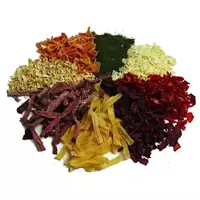Dried vegetables

Products began to be harvested using the process of natural drying even at the time of the birth of human civilization. Drying can be considered the easiest way to preserve the distinctive taste and consumer characteristics of vegetables, as well as fruits, berries and mushrooms, meat, as well as fish. In ancient times, direct sunlight or shade, as well as natural drafts, were used to dry food.
In the modern food industry, dried vegetables or fruits, as well as other food products, are made using special industrial dryers. During the drying process, food loses most of the water, while destroying the natural habitat of various microorganisms. As a result, dried vegetables acquire the ability to maintain their taste and consumer properties for a much longer time.
It is worth noting that the chemical composition of dried vegetables is also enriched with all useful compounds and vitamins that are contained in the composition of fresh foods. However, a number of useful compounds may evaporate during the drying process. this is due to the fact that the fresh product undergoes thermal treatment during the drying process.
Most often in the food industry, such types of dried vegetables are harvested as bulb onions, garlic, white cabbage, potatoes, table carrots and beets, as well as celery root, parsnips, parsley, green peas, parsley greens, dill and celery. In addition, mixtures of dried vegetables are popular, which is usually used in the manufacture of soups, as well as vegetable dishes and side dishes.
Notably, dried vegetables significantly reduce cooking time. This is primarily due to the fact that dried vegetables belong to food products that have undergone additional temperature treatment. Dried vegetables can be an essential ingredient for your culinary experiments, not just when fresh produce is not available. Dried vegetables can be used as seasoning.
In addition, dried vegetables belong to dietary foods, since unlike pickled or salted vegetables, the product does not contain salt or vinegar. As a result of research, it was found that dried vegetables include nitrogenous compounds, sucrose, pectin, and in addition minerals of natural origin.
Dried vegetables have many advantages, but the main disadvantage is to consider changes in the vitamin and mineral composition, as well as the organoleptic properties of products during the drying process. For the procurement of dried vegetables at home, it is better to use a special household dryer. Natural drying requires a much longer period of time and certain weather conditions.
Before drying, I grate the vegetables, wash them thoroughly, and then cut or grate them. For example, it is better to cut onions into rings, sweet peppers or potatoes into straws, and dry carrots with beets in grated form. It is better to store dried vegetables in a dry and dark place in containers that will not let moisture through, which will allow you to preserve the taste and consumer characteristics of the product for a long time.
dried vegetables 250 kCal
Energy value of dried vegetables (Ratio of proteins, fats, carbohydrates - ju):
Proteins: 37.5 g (~ 150 kCal)
Fats: 0.7 g (~ 6 kCal)
Carbohydrates: 23.4 g (~ 94 kCal)
Energy ratio (bj | y): 60% | 3% | 37%
 Español
Español Français
Français Português
Português Русский
Русский 简体中文
简体中文 繁體中文
繁體中文 日本語
日本語 한국어
한국어 العربية
العربية Türkçe
Türkçe Қазақ
Қазақ Deutsch
Deutsch Italiano
Italiano Українська
Українська
